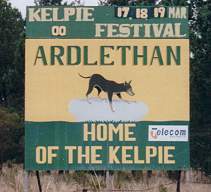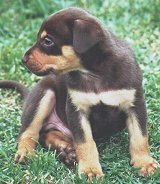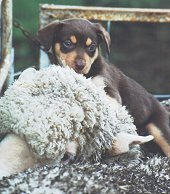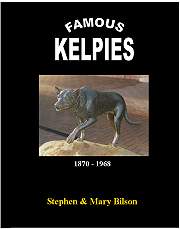The background of the Australian Working Kelpie is fascinating and complex. Few people outside of Australia even know that the breed exists, yet in Australia this dog is worked on thousands of properties right across the land and saves millions of dollars in labour costs. There have been statues erected to it and had stories and poems done in its honour.
In Britain and to some extent America it is thought that the only true heading type of dog is a Border Collie but this is not the case. The Kelpie is a superb heading dog with an enormous amount of natural sheep working ability. That is not to say that the Kelpie is better than the Border Collie or visa versa. The two sheepdogs tend to compliment each other and both are used in Australia.
The origin of the Kelpie like many working dogs world-wide came from beginnings in Britain. However it must be stressed now that the Kelpie is not and never was a Border Collie! The Kelpie came from special line bred strains of British Working Collie just as the Bearded Collie, Shetland Sheepdog, Old English Sheepdog, Smithfield, Collie Rough (Scotch Collie) the American McNab and the Border Collie as we know today came from other strains of Working Collie. The Border Collie breed was not formed until approximately 25 - 30 years after the Australian Working Kelpie. The first Border Collie imported into Australia was Hindhope Jed and was actually bought here by the famous King & McLeod Kelpie Stud, in 1901.


NOONBARRA DUSTY VISITS THE STATUE OF GLEESON'S KELPIE AT ARDLETHAN
Many people ask if the Australian native wild dog, the Dingo played a major part in the Kelpie breed. The answer is yes! There is no doubt that the Dingo was used a number of times by various breeders and stockmen over a long period. The only question is how much influence did the Dingo have in the breed and how early was it's blood used.
In the early days of Australia we used shepherds to watch over the flocks of sheep. Many of these shepherds were originally bought out from Britain and were doing the same job as they had done for years. Others were Chinese and Aboriginals. In the mid 1800's the shepherds were replaced with fencing and today we have no real shepherds in Australia.
Australia also started to breed its own special kind of sheep called the Australian Merino. These sheep were far more nervous and panicked more than the British and South African breeds we also had in Australia at that time and therefore they were far more difficult to handle. Added to this was the fact that without shepherds the sheep had less contact with humans and became almost wild.
The original sheepdogs that had been continually imported since the early settlement were not capable of handling these new sheep or the Australian conditions to the best advantage. A few breeds were however a big improvement on the previous importations. One of the bloodlines we know a lot about was the North County Collies - or Rutherford strain. These specialist sheepdogs were bred pure in Scotland since 1760. In the 1800's John Rutherford & his family settled in Australia and of course bought their dogs with them. They also continued to import their Scottish breed for a number of years as well as breeding here.
A number of other breeders were impressed by this strain and also used them in their own breeding programs. This was most notably done by Gerald Kempe in NSW and later South Australia, and the Tully family in NSW. In the same general area of NSW near the present town of Young, the partnership of Elliott and Allen imported two Working Collies by the name of Brutus and Jenny. These dogs were not of the Rutherford strain, but came from another of the good Working Collie strains.
The pair of dogs were mated on the voyage over and Jenny whelped soon after arriving. Both of these dogs were impressive workers. A pup from this mating was bred to Jack Gleeson's good bitch called 'Kelpie' to produce the famous 'King's Kelpie'.
Gleeson had acquired his sheepdog called Kelpie, by swapping a horse for her at Warrock Station in Victoria in the 1870's. Kelpie was bred on the station owned by Mr. George Robertson.
Jack Gleeson also acquired a black dog known as Tullys Moss a little later from his friend, Mark Tully in NSW. Moss was bred from two Rutherford Sheepdogs but bred in Australia at Yarrawonga Station. Gleeson's Kelpie was mated at least twice to Moss.
Although in the original few years these dogs were already highly respected workers they were not known widely in Australia until the dog now referred to as Kings 'Kelpie' , a daughter of Gleeson's Kelpie, won a large sheepdog trial event at Forbes in NSW 1879. This trial was well publicised and involved some of the most outstanding sheepdogs in Australia, including Gibson's Tweed coming across from Tasmania.
The judge was Mr. Phil Mylecharane, considered by most to be an expert on sheep & sheepdog matters. Kelpie put on a brilliant display at this trial and impressed all who saw her including the judge. She was placed equal first with Charles Gibson's Tweed. Kelpie's win at this trial and her ability and style was talked about and word got around quickly. Soon people everywhere wanted to buy a 'Kelpie' pup. For a few years only pups from Kings Kelpie were given the name Kelpie but as time went on the name was applied to her relatives as well.
The next dog to become well known was the 'Barb', named after a famous Australian racehorse. This dog introduced Rutherford blood to the Kelpie line. Sired by Tully's Moss, (Yarrawonga Clyde x Lassie ), The dam was Sally, ( Grand daughter to Brutus and Jenny). Barb was a solid looking all black dog and gained a reputation as a strong forcing type dog. His offspring were referred to as Barbs and they became established as a separate strain of Kelpies for a number of years. Even today, although there are no true Barbs left, many people still sometimes refer to a black Kelpie as a Barb.
In the late 1800's another great Kelpie sealed the high reputation of the breed forever. This dog was John Quinn's blue Kelpie, Coil. (Often referred to today as 'The Immortal Coil'.) John Quinn was already well known for having excellent dogs and was the winner of the first Sydney Sheepdog Trials in 1896 with a Kelpie called 'Gay'.
In 1898, John Quinn took Coil to the Sydney Trial hoping to repeat his previous success. He did that and more ! Coil completed the trial with a perfect score, 100 points. With the finals to be run the next day, Coil was a hot favourite. That evening on the way back to the hotel, Coil jumped out of the horse-drawn carriage and broke his leg on the wheel spokes. Fortunately among other talents John Quinn was a qualified Veterinarian and that night set his leg.
Next day working on three legs and swinging the damaged one, Coil scored another perfect run of 100 points and history was made. Coil went on to win a number of other trials but he became better known as a superb sire of outstanding Kelpies. From the written reports of the period, it seems anyone who saw Coil work could not help but be impressed.
In 1900 a unique partnership was formed between Charles Beechworth King and Alec McLeod, a very astute businessman. Mr. King was one of a large family involved with Kelpies for many decades. His cousin, Charles T.W. King owned Kings Kelpie.
The Stud known as King & McLeod became famous across Australia as well as many other parts of the world. They were determined to buy and breed the best sheepdogs in Australia. They used the prestigious Sydney trials as a barometer of their success and once boasted that they owned or bred every sheepdog that had won a major trial in Australia over a period of 25 years.
In 1901 the King & McLeod partnership purchased the first Border Collie to come into Australia. This was Hindhope Jed, a black and tan bitch, bred by John Elliott of Jedsburgh in Scotland. This bitch was originally sent to James Lilico in New Zealand but Alec McLeod visiting in 1901 bought her not long after she had arrived there. She had already won trials in Scotland as well as at least one in New Zealand and then in 1903, she won the big trial at Sydney in Australia.
In 1903, they made moves to purchase the blue Kelpie, Coil, from John Quinn. Mr. Quinn didn't want to sell him. McLeod persisted continually until they were finally able to obtain the dog for an undisclosed sum. They also purchased a second top working Kelpie of Quinns, another Blue dog called Wallace. Wallace was the winner of the Sydney trial in 1899.
Another Kelpie that made the King & McLeod Stud a household name was Biddy. Biddy was a small prick-eared red & tan coloured bitch. She was heavily promoted by the Stud as the Champion Sheepdog of Australia after winning Sydney trials in 1902.
Biddy was often quoted by Alec McLeod as being typical of the Kelpie breed. She also had a famous trick of herding a small chick into a jam tin. Mr. McLeod promoted this unusual feat quite widely and even tried to get sponsorship from IXL, the Australian Jam Company.
The King & McLeod Stud went on until about 1930. John Quinn was also still breeding on his same bloodlines until the early 1930's. One of the last dogs he bred was the big blue Kelpie, Boy Blue. This dog was made famous by Jack Goodfellow of the Currawang Kelpie Stud.
The history of the Kelpie can never be complete without mention of the early handlers and breeders that kept the Kelpie name famous. One of these was Frank Scanlon (Scanlon Kelpie Stud). Frank stated breeding as a young boy and was still breeding up to his death in 1990 when he was in his late 80's. Frank had connections with many of the greatest Kelpies that ever lived. In the early days he had used some of the King & McLeod lines, but the man he said who most influenced him was Tom Bower. Tom is almost forgotten today but his breeding contributed a lot to the Kelpie in the early days.
In the 1940's, there were many first class Kelpies working in Australia. Scanlons Dell bred by Stan Collins but owned and worked by Frank Scanlon made a name for herself as a first class breeder. She also won a number of trials but her contribution to the Kelpie breed as a breeder had far greater importance. Her breeding also had a strong influence for many generations.
In the 1950's there was a sheepdog that made a big name for himself. This dog was 'Johnny' bred by Patrick Walker of Tenterfield NSW. Johnny was controversial from the start because although he was always referred to as a Kelpie and certainly looked like one, he had some Border Collie blood in him. One of his grandsires was Braw Speed, an imported Border Collie.
Johnny was regarded by most that saw him work as by far the greatest trial dog of his period bar none. He was handled superbly by Athol Butler, a perfectionist on the trial field who took the sport very seriously. Athol also did extremely well with another pure bred Kelpie, the big cream dog, Porters Don.
In more recent years many Kelpies have made a name for themselves. Among these are dogs like Liscannor Marco, Liscannor Pace, Barambogie Mack, Capree Watch, Noonbarra Butch, Milburn Basil, Liscannor Kay, Glenlogie Rex and Glenlogie Lucky. Most of these dogs have won on trial fields usually in Utility trials, but they were also highly regarded as breeders of good all-round dogs. These dogs also worked the properties at home and most of their offspring never got to see a trial ground but were rated very highly as Station (Ranch) Workers.
The Kelpie today is the main sheepdog working in Australia, helping to work nearly 180 million sheep. Thought of as a tough dog that is able to withstand the punishing heat and long distances typical of many Australian properties. The Kelpie however is also at home on small farming properties bringing in the cows or rounding up a small mob of sheep.
These days the Kelpie is finding a growing acceptance in many countries that need good dogs to work stock including Canada, the United States of America, Argentina, Iran, Mexico, Sweden, Malaysia, South Africa, Germany, Wales, Scotland, Switzerland, Ireland, Russia, Belgium, Denmark, Hawaii (USA), Netherlands (Holland), Norway, Finland, Italy, New Zealand, Hong Kong, England, Korea, Japan, Saudi Arabia, Kuwait, New Caledonia and Norfolk island etc.
|
|


Noonbarra Working
Kelpie Stud
Mary and Stephen Bilson.
539 Lookout Road, Mullion Creek via Orange NSW 2800
Postal Address: P.O. Box 1374, Orange
NSW 2800, Australia
Ph. (02) 6366 0499
![]()
Email us
Information on Kelpie history & the outstanding Kelpies of the past can be found in the latest edition of our book

Softcover 136 pages.
CLICK HERE FOR MORE DETAILS & PAYMENT ETC.
THE ROCKYBAR KELPIES
A GUIDE TO ONE OF THE BEST KNOWN KELPIE STUDS OF THE 20TH CENTURY
 We
think this book would be an enjoyable read for anyone with even a passing
interest in the Kelpie. It would be a great guide for breeders and trainers with
information that is impossible to get anywhere else!
We
think this book would be an enjoyable read for anyone with even a passing
interest in the Kelpie. It would be a great guide for breeders and trainers with
information that is impossible to get anywhere else!
The Rockybar Stud, owned by Les Tarrant, was one of the most famous in Australia for half a century and their influence can be seen in Kelpies all over the world today.
Les Tarrant started with Kelpies in the 1930's. He led a life of droving, mustering and working with horses and livestock. In 1950, he set up the Rockybar Kelpie Stud in the far north-western districts of NSW.
We look at some bush characters and old dog men such as the remarkable priest of Goondiwindi, Father McCormack, Stanley McMaster, Frank Scanlon, Stan Collins, and more. We look at the individual dogs in the old Rockybar lines and the more modern lines (after 1980). We have a huge section on Les Tarrant in his own words explaining how to breed Kelpies and the problems and pitfalls to avoid. There is a good chapter of the book dedicated to how to train Kelpies the Rockybar way. Another chapter is on yard work and yard trials.
There are plenty of photographs and some were very hard to obtain. Many (probably most) would never have been seen by the general public before.
Large A4 format. B/W photos throughout. 166 pages.
CLICK HERE FOR MORE DETAILS & PAYMENT ETC.
New 3rd edition of this very popular manual designed for all Kelpie owners of every level from raw beginners through to experienced trainers. This practical manual deals with everything involved in owning and training a Kelpie to ensure he grows up to be a well mannered, obedient dog.
The book is not about training on livestock! It deals with general obedience training, socialising your Kelpie, feeding, crating, toilet training, preventing problem behaviour, dominance issues, car travel, bathing, digging holes, stealing food, walking on a lead, coming when called... and much more.
Over 100 pages.